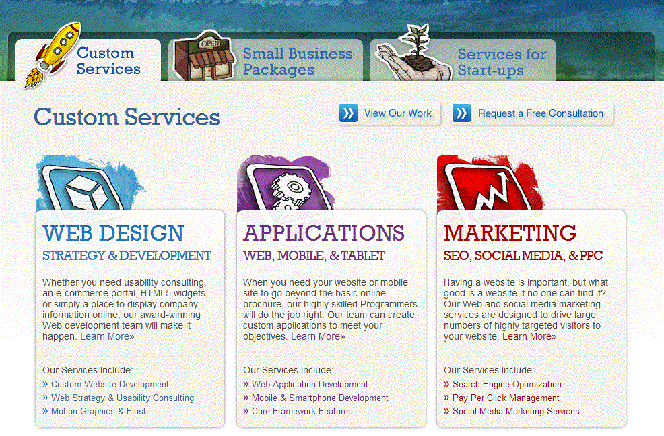When redesigning your website, or building a website for the first time, there are a lot of factors that go into creating something easy to use and that will visually impress visitors. You may think throwing some well-written copy on a simply designed page is going to be an easy way to create the pages of your website, but there are a lot of factors that go into ensuring your landing pages help you accomplish your goal: increasing site traffic and conversions, which brings in more money.
For a landing page to be effective, it needs to accomplish its job both visually and from a search perspective. We’ll cover the important guidelines to keep in mind when designing a page, as well as how your landing pages play an important role in your search marketing strategy. While these two ideas might seem independent of each other, they complement each other to help accomplish what should be your end goal: creating a website that drives the right users to the correct pages of your website, increasing conversions (and helping your bottom line).
Design Tips to Keep in Mind for Your Landing Pages
Keep it Clean
When someone first arrives on your landing page, they’ll get an impression of that page, and your site in general, in a matter of seconds. This first impression is vital in ensure visitors will stick around and not bounce from your site to your competitor’s site. Here are some tips you should follow to ensure your content is clean, easy to digest and won’t scare away your next prospective customer.
When writing the text for your website, make sure you not only make the content easy to read, but also easy to view. Break up long blocks of text to put them into small paragraphs to help visitors digest chunks of information. Keep paragraphs three sentences long or so to prevent you from overwhelming visitors with information.
 This is all the content that appear above the fold on 352 Media Group’s home page. By keeping things concise, visitors can easily digest who we are and what we do.
This is all the content that appear above the fold on 352 Media Group’s home page. By keeping things concise, visitors can easily digest who we are and what we do.
Also ensure you break up information with relevant, concise headlines, preferably including some keywords. People scan pages online, not read them fully, so make sure your headings break up the text into relevant sections and put the information into some sort of prioritized order, with the most relevant, important information at the beginning and the less important information near the end.
Make it Pretty
Make sure you don’t have just text on the page. Include visually compelling images on your page (preferably nothing in Flash) that draw in your visitors, but ensure whatever images you choose are reflective of the information on the page and not stock images that make visitors say, “Huh?” You’ll also want to check that the images don’t take too long to load as slow load times can turn away visitors.

352 Media Group’s services page breaks down our services into categories and provides just enough detail to tell visitors where they information they’re looking for is located.
Also pick colors that offer enough contrast to make it easy to read what’s on the page. Your company colors might be blue and green, but don’t pair them together unless there is enough contrast between all the colors to make it easy to read. The colors on your website should also be reflective of your company’s branding so it is clear that your website and any other branded materials look cohesive.
Call Them to Action
Once you get people to your website, what do you want them to do? Fill out a form for more information? Sign up for your newsletter? Have them speak with a representative? Having a clear call to action will make it easier for people to complete your goal, whatever that may be.
Once you know how your page will look and the information you’ll have on there, you want to start thinking about developing a great search engine optimization strategy to ensure you’re getting the right people to find your website. Here are some tips to keep in mind when creating your SEO strategy.
SEO to Remember for Your Landing Pages
Pick the Right Keywords for the Right Pages
Once you know the type of content that’s going to be on each landing page, you’ll want to develop a keyword strategy to drive search traffic to the relevant landing pages of your website. When doing your keyword research, ask yourself: “What words would I use to describe the information that’s on this page?” You want to make sure that the terms you use are both general enough that people will search them frequently, but not so broad that there will be an abundance of competition for those terms.
You also want to make sure that the keywords you use are reflective of the page on which they appear. For example, if you sell items for pet owners, including food, treats, toys, beds and collars, you want to make sure the appropriate words and phrases are used on the right pages. For example, “dog beds” and “cat beds” should appear on the landing page for the bed products while they phrases “dog treats” and “cat treats” appear on the page devoted to pet treats. This will help ensure that when someone enters that query into Google, the landing page from your website that appears in search results is the landing page that is most applicable to their query.
Make it Unique
One of the basic tenets of SEO is you don’t want to have duplicate content from your site available anywhere else online. Make sure anything you put on your website is something that is unique an applicable to what your business is selling or doing.
Also make sure that you link back to other pages of your website and use the appropriate keywords as anchor text when doing so. Creating a strong internal linking structure will appeal to search engines and also let them know which keywords are relevant for the content on specific landing pages. Search engines can read the anchor text over hyperlinks, and this anchor text is what sends them the signal of what words and phrases are relevant for the information on that page. Going back to the pet supply website example, the more you link back to your pet treats page using some of the keywords for that page, the more likely search engines will think that page is relevant for those terms.
Find a Way to Track It
While you’re in the process of building your website, you need to decide how you’ll track what users are doing on your website. Are there certain product pages that are grossly outperforming others? Do you have a high bounce rate, meaning people come to your home page and then leave? How many visitors are you getting each month, and how are they currently finding your website?
All of these things are items that you’ll be able to track using a web analytics tool like Google Analytics. Using a web analytics tool, you can glean data from site visits and determine what is working well for your website, what isn’t working so well, and help you identify any big problems that you might be encountering, such as a skyrocketing bounce rate.
You can also set up goal tracking in Analytics to measure how your calls to action are performing. Are people signing up for your newsletter or requesting a quote for your services? Initially you might not have as many goal completions as you would like, but over time, your conversion rate should start improving. If they don’t, you can take that as a sign there are some things for you to change on your site, such as revising a keyword strategy or seeing if there is a better place to include your calls to action.
These are just the big picture components that go into developing a well thought out landing page. You’ll want to keep all of these factors in mind as you shape each landing page of your website to ensure that it’s doing everything you want it to from both a design and a marketing perspective.
Opinions expressed in the article are those of the guest author and may not reflect the views of Webaholic.
Amy Moczynski is a marketing account director for 352 Media Group, a web development and digital marketing agency offering its clients a better experience.

